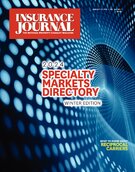As claim severity rises, U.S. personal auto results are on the decline, according to AM Best’s Market Segment Report, issued in December 2023.
The 112.2 net combined ratio in 2022 for personal auto was an almost 11-point deterioration from 101.5 in 2021, and about 10 points over the ten-year average and median combined ratios for the line.
Deteriorating liability and physical damage resulted in a more than $4 billion net underwriting loss in 2021 for personal auto insurers. Insurers find rates can’t keep pace with the increasing number of accidents and costs such as economic inflation, supply chain disruptions and technological advances in vehicles, which increase claims costs. In 2022, inflationary pressures on physical damage claims costs, rising medical expenses and greater claims severity caused the more than $33 billion underwriting loss. Even as insurers pursued premium increases, underwriting results in 2022 continued to trend adversely through the first half of 2023.
Christopher Graham, senior industry analyst and co-author of the market segment report, noted in a video discussion of the report that even if there had been no increase in loss costs, carriers would “still need double-digit rate increases just to get to [the] level of being able to break even.”
Worsening accident severity has been a primary driver of the rising claims costs and the deteriorating overall results. “Workplace patterns have changed post-pandemic with work-from-home arrangements, reducing the number of vehicles on the road. However, driver inattentiveness and riskier driving habits have become more problematic in the last few years, and as a result, auto severity has worsened,” said Graham.
Personal auto loss severity led to a significant, almost 13-point jump in the net loss and loss adjustment expense ratio for the private passenger auto line in 2022. The average cost per private passenger auto claim increased 16% in 2022 year over year, after rising by 11% in 2021. The average defense and cost containment expense increased by 29% and adjusting and other expenses increased by 18%.
However, the National Highway Traffic and Safety Administration has reported that the fatality rate declined in 2022 from 2021 and that the decline in the fourth quarter of 2022 was the third straight decline after seven quarters of increases.
The net results were slightly offset by carriers benefiting from a lower underwriting expense ratio given higher premium levels. “AM Best-rated carriers have said that they are reassessing their personal auto portfolios and implementing steps to address selection and price adequacy concern, but the time-consuming regulatory process for rate increases, which varies by jurisdiction, has made it difficult for insurers to stay ahead of deteriorating severity trends and address rate needs in real time,” said David Blades, associate director.
Despite the challenging market dynamics, 17 of the top 20 U.S. insurers grew their premium base in 2022, reflecting an intent to attain rate adequacy to better offset claims costs.
Topics Auto Claims Pricing Trends
Was this article valuable?
Here are more articles you may enjoy.


 Let Good Adjusters, Not Expensive Lawyers, Make the Difference on Claims, CEO Says
Let Good Adjusters, Not Expensive Lawyers, Make the Difference on Claims, CEO Says  US P/C Insurers Post Best Q1 Underwriting Result In 17 Years
US P/C Insurers Post Best Q1 Underwriting Result In 17 Years  QBE to Non-Renew $500M of North American Mid-Market Biz
QBE to Non-Renew $500M of North American Mid-Market Biz  BlackSuit Cybercrime Gang Blamed in CDK Hack That Roiled Car Dealers
BlackSuit Cybercrime Gang Blamed in CDK Hack That Roiled Car Dealers 


